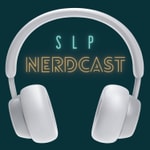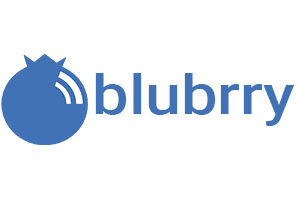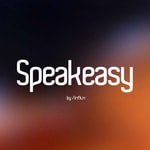SLP Nerdcast – Details, episodes & analysis
Podcast details
Technical and general information from the podcast's RSS feed.

SLP Nerdcast
Kate Grandbois, MS, CCC-SLP, BCBA, LABA; Amy Wonkka, MA, CCC-SLP.
Frequency: 1 episode/13d. Total Eps: 158

Recent rankings
Latest chart positions across Apple Podcasts and Spotify rankings.
Apple Podcasts
🇬🇧 Great Britain - courses
29/07/2025#32🇬🇧 Great Britain - courses
28/07/2025#94🇺🇸 USA - courses
28/07/2025#94🇬🇧 Great Britain - courses
27/07/2025#65🇺🇸 USA - courses
27/07/2025#85🇬🇧 Great Britain - courses
26/07/2025#47🇺🇸 USA - courses
26/07/2025#71🇺🇸 USA - courses
25/07/2025#62🇺🇸 USA - courses
23/07/2025#90🇨🇦 Canada - courses
22/07/2025#85
Spotify
No recent rankings available
Shared links between episodes and podcasts
Links found in episode descriptions and other podcasts that share them.
See all- https://www.thetrevorproject.org/
829 shares
- https://www.perplexity.ai/
334 shares
- https://chatgpt.com/
256 shares
RSS feed quality and score
Technical evaluation of the podcast's RSS feed quality and structure.
See allScore global : 79%
Publication history
Monthly episode publishing history over the past years.
Stronger Together: Empowerment through Allyship and Cultural Humility in CSD
Season 5 · Episode 16
lundi 27 mai 2024 • Duration 01:04:04
Speech Language Pathology: Continuing Education Courses by SLP Nerdcast
Course Title: Stronger Together: Empowerment through Allyship and Cultural Humility in CSD
Get .1 ASHA CEUs and view the full course landing page: https://courses.slpnerdcast.com/courses/stronger-together-empowerment-through-allyship-and-cultural-humility-in-csd-abje0136
Earning Speech-Language Pathology CEUs Online is Simplified with SLP Nerdcast.
On SLP Nerdcast you’ll find SLP Continuing Education Courses, Masterclasses and Clinical Resources.
To learn more about our services visit ▶ https://bit.ly/SLPNERDCAST
To learn more about our membership and save 10% on your first year of membership visit ▶ https://bit.ly/SLPNerdcastMembership use code “YouTubeNerd” to save.
Learning Objectives:
Define allyship and list two reasons why allyship is not a selfless endeavor
Describe the importance of allyship in speech language pathology
List at least two action steps that clinicians can take to show professional allyship
References & Resources:
Asian Pacific Islander Speech-Language-Hearing Caucus
Disability Caucus:
Men's Constituency Caucus: [email protected]
Middle East and North Africa Caucus: [email protected]
National Black Association for Speech-Language and Hearing (NBASLH)
Gaudry, A.J.P. (2011). Insurgent Research. Wicazo Sa Review 26(1), 113-136. https://doi.org/10.1353/wic.2011.0006.
Community, Connection, and Social Justice in Speech-Language Pathology (Part 2)
Season 5 · Episode 15
mardi 14 mai 2024 • Duration 44:25
Speech Language Pathology: Continuing Education Courses by SLP Nerdcast
Course Title: Community, Connection, and Social Justice in Speech-Language Pathology (Part 2)
Get .05 ASHA CEUs and view the full course landing page: https://courses.slpnerdcast.com/courses/community-connection-and-social-justice-part-2-abje0135
Earning Speech-Language Pathology CEUs Online is Simplified with SLP Nerdcast.
On SLP Nerdcast you’ll find SLP Continuing Education Courses, Masterclasses and Clinical Resources.
To learn more about our services visit ▶ https://bit.ly/SLPNERDCAST
To learn more about our membership and save 10% on your first year of membership visit ▶ https://bit.ly/SLPNerdcastMembership use code “YouTubeNerd” to save.
Learning Objectives:
Describe effective components of a social justice curriculum
List two action steps for implementing a social justice curriculum with staff and colleagues
List two action steps for implementing a social justice curriculum with students
References & Resources:
White People Challenging Racism Workshop
[Revisit] A Crucial Alliance: SLPs and Mental Health Professionals
Season 3 · Episode 20
lundi 26 février 2024 • Duration 01:04:34
Get .1 ASHA CEU here
Episode Summary
Ever feel under-equipped to deal with the counseling demands that often pop up in your daily SLP work? You’re not alone! So much of what we do as SLP’s is “grief work” and many of us find ourselves in over our heads at times with the counseling needs of our clients or students and their families. This week, Kate and Amy capitalize on their “forced friendship” with Beverly Montgomery of Lex Communicate to talk about the power of alliances with mental health professionals in addressing the holistic needs of individuals with communication differences and the caregivers who support them. Beverly discusses how mental health needs touch each case we serve and offers actionable suggestions for how Interprofessional Education (IPE) and Interprofessional Practice (IPP) can help us go beyond due diligence and realize better outcomes for those we serve. Tune in to explore which mental health professionals may be unexpected allies and obtain some simple strategies to help you manage these powerful relationships when scopes of practice overlap. Our clients and students are so complex, you may often feel that you “have a flashlight when you need a flood light” to recognize all of the facets that compose client and family needs. Beverly’s approach to interdisciplinary practice Illuminates the complexities of your toughest cases. If you find “other stuff” getting in the way of therapeutic progress for your clients or students, this is the episode for you.
Learning Outcomes
State the purpose(s) and benefit(s) of interprofessional collaboration
Define Interprofessional Education (IPE) and Interprofessional Practice (IPP)
Describe a decision-making process for when and how to make mental health referrals
Identify a variety of collaborative partners both within and outside their organization
References
American Speech-Language-Hearing Association. (2010). Roles and responsibilities of speech-language pathologists in schools [Professional Issues Statement]. Available from www.asha.org/policy.
Dobbs-Oates, J., & Wachter Morris, C. (2016). The case for interprofessional education in teacher education and beyond. Journal of Education for Teaching, 42(1), 50–65. https://doi.org/10.1080/02607476.2015.1131363
Elleseff, T. (2014). Creating Successful Team Collaboration: Behavior Management in the Schools. Perspectives on School-Based Issues, 15(1), 38–44.https://doi.org/10.1044/sbi15.1.38. Erickson, K. A. (2017). Comprehensive Literacy Instruction, Interprofessional Collaborative Practice, and Students with Severe Disabilities. Retrieved March 3, 2020, from https://doi.org/10.1044/2017_AJSLP15-0067
Farber, J. G., & Klein, E. R. (1999). Classroom-based assessment of a collaborative intervention program with kindergarten and first-grade students. Language, Speech, and Hearing Services in Schools, 30, 83- 91.
Kent-Walsh, J., & Light, J. (2003). General education teachers' experiences with inclusion of students who use augmentative and alternative communication. Augmentative and Alternative Communication, 19, 104–124.
Novak, J.M., & Kapolnek, K.M. (2001). Speech-language pathologists serving clients with mental illness: A collaborative treatment approach. Contemporary Issues in Communication Science and Disorders, 28, 111-122.
Pfeiffer, Danika L., Pavelko, S. L., Hahs-Vaughn, D. L., & Dudding, C. C. (2019). A National Survey of Speech-Language Pathologists Engagement in Interprofessional Collaborative Practice in Schools: Identifying Predictive Factors and Barriers to Implementation. Language, Speech, and Hearing Services in Schools, 50(4), 639–655. https://doi.org/10.1044/2019_lshss-18-0100
Roepke, E., Greenwell, T., & Brosseau-Lapré, F. (2019). Service delivery for children with speech sound disorders: Evidence for the Quick Articulation! model. EBP Briefs, 14(2), 1–9. Bloomington, MN: NCS Pearson, Inc.
Throneberg, R. N., Calvert, L. K., Sturm, J. J., Paramboukas, A. A., & Paul, P. J. (2000). A Comparison of Service Delivery Models: Effects on Curricular Vocabulary Skills in the School Setting. Retrieved March 21, 2020, from https://doi.org/10.1044/1058-0360.0901.10
Online Resources
World Health Organization: Interprofessional Education & Practice
American Speech and Hearing Association: Interprofessional Education and Practice
Speaker Disclosures:
Beverly Montgomery financial disclosures: Beverly is the owner and operator of Lex Communicate. Beverly Montgomery non-financial disclosures: Beverly has family members with diagnoses discussed in the course and has a professional bias towards integrated, collaborative social communication treatment.
Kate Grandbois financial disclosures: Kate is the owner / founder of Grandbois Therapy + Consulting, LLC and co-founder of SLP Nerdcast. Kate Grandbois non-financial disclosures: Kate is a member of ASHA, SIG 12, and serves on the AAC Advisory Group for Massachusetts Advocates for Children. She is also a member of the Berkshire Association for Behavior Analysis and Therapy (BABAT), MassABA, the Association for Behavior Analysis International (ABAI) and the corresponding Speech Pathology and Applied Behavior Analysis SIG.
Amy Wonkka financial disclosures: Amy is an employee of a public school system and co-founder for SLP Nerdcast. Amy Wonkka non-financial disclosures: Amy is a member of ASHA, SIG 12, and serves on the AAC Advisory Group for Massachusetts Advocates for Children.
Course Disclosure - Financial and In-Kind
Funding for this course was provided by one of our Corporate Sponsors, Vooks.
Time Ordered Agenda:
15 minutes: Introduction, Disclaimers and Disclosures
25 minutes: Descriptions of the purposes and benefits of interprofessional collaboration, interprofessional education, and interprofessional practice
15 minutes: Descriptions of the decision-making process for when and how to make mental health referrals
10 minutes: Descriptions of a variety of collaborative partners both within and outside their organization
5 minutes: Summary and Closing
Disclaimer
The contents of this episode are not meant to replace clinical advice. SLP Nerdcast, its hosts and guests do not represent or endorse specific products or procedures mentioned during our episodes unless otherwise stated. We are NOT PhDs, but we do research our material. We do our best to provide a thorough review and fair representation of each topic that we tackle. That being said, it is always likely that there is an article we’ve missed, or another perspective that isn’t shared. If you have something to add to the conversation, please email us! Wed love to hear from you!
__
SLP Nerdcast is a podcast for busy SLPs and teachers who need ASHA continuing education credits, CMHs, or professional development. We do the reading so you don’t have to! Leave us a review if you feel so inclined!
We love hearing from our listeners. Email us at [email protected] anytime! You can find our complaint policy here. You can also:
Follow us on instagram
Follow us on facebook
We are thrilled to be listed in the Top 25 SLP Podcasts!
Thank you FeedSpot!
Language Ideology and Linguistic Diversity in Speech and Language Pathology
Season 2 · Episode 26
dimanche 28 mars 2021 • Duration 01:00:04
Get .1 ASHA CEU here
Episode Summary:
In this week’s episode, guest expert Chelsea Privette helps us get real about language ideology and our responsibilities to shift the “standard” as language professionals supporting linguistically and culturally diverse communicators. There was more than one “ah-ha” moment across this Nerdcast as Chelsea helps us consider tangible strategies to shift our thinking and practice around core issues in the field. There’s also a healthy dose of challenging the status-quo, urging us to question many of our long-standing speech-language pathology paradigms. Come along with us on the journey - you might get a little uncomfortable - but open your mind, fill up your wine glass, and tune in to learn about language ideology in the United States and what it has to do with you as an SLP.
Chelsea is a doctoral candidate at the University of Arizona researching bilingualism and the interactions of Spanish and African American English in preschoolers. You can learn more about Chelsea here.
Learning Outcomes
1. Define the dominant language ideology in the United States.
2. Describe linguistic environment in inclusive terms.
3. Distinguish between inclusive and anglocentric terminology in clinical documentation and professional meetings.
References
Artiles, A. J. (1998). The dilemma of difference: Enriching the disproportionality discourse with theory and context. The Journal of Special Education, 32(1), 32-36.
Berthele, R. (2002). Learning a second dialect: A model of idiolectal dissonance. Multilingua, 21, 327-344.
Blum, S. D. (2017). Unseen WEIRD assumptions: The so-called language gap discourse and ideologies of language, childhood, and learning. International Multilingual Research Journal, 11(1), 23-38.
Brandt, D. (1998). Sponsors of literacy. College Composition and Communication, 49(2), 165-185.
Baugh, J. (2003). Linguistic profiling. In S. Makoni, G. Smitherman, A. F. Ball, & A. K. Spears (Eds.), Black linguistics: Language, society, and politics in Africa and the Americas (pp. 155-168). Routledge.
Boser, U., Wilhelm, M., & Hanna, R. (2014). The Power of the Pygmalion Effect Teachers Expectations Strongly Predict College Completion. Center for American Progress. Retrieved from https://files.eric.ed.gov/fulltext/ED564606.pdf
Carter, P. M. (2013). Shared spaces, shared structures: Latino social formation and African American English in the U.S. South. Journal of Sociolinguistics, 17(1), 66-92.
Goldstein, L. M. (1987). Standard English: The only target for nonnative speakers of English? TESOL Quarterly, 21(3), 417-436.
Hill, J. H. (2008). The everyday language of white racism. Wiley-Blackwell.
Minow, M. (1990). Making all the difference: Inclusion, exclusion, and American law. Cornell University Press.
Oetting, J. B. (2020). General American English as a dialect: A call for change. The ASHA LeaderLive. https://leader.pubs.asha.org/do/10.1044/leader.FMP.25112020.12/full/.
Oetting, J. B., Gregory, K. D., & Rivière, A. M. (2016). Changing how speech-language pathologists think and talk about dialect variation. Perspectives of the ASHA Special Interest Groups SIG 16, 1(1), 28-37.
Purnell, T., Idsardi, W., & Baugh, J. (1999). Perceptual and phonetic experiments on American English dialect identification. Journal of Language and Social Psychology, 18, 10-30.
Stanford, S., & Muhammad, B. (2018). The confluence of language and learning disorders and the school-to-prison pipeline among minority students of color: A critical race theory. American University Journal of Gender, Social Policy & the Law, 26(2), 691-718
Online Resources:
Larson, A. (2021). Bias in Bilingualism: Changing How We Talk About Language Learners. Bilinguistics. https://bilinguistics.com/catalog/speech-pathology-ceus/webinar/bias-in-bilingualism/
Summarizes Soto, Larson, & Olszewski paper (forthcoming?)
Stanford, S. (2021). Transforming Our Language to Change Clinical Narratives for Youth with Disorders. Bilinguistics. https://bilinguistics.com/catalog/speech-pathology-ceus/webinar/transforming-your-language/
Baugh, J. (2019). The significance of linguistic profiling. TEDxEmory. https://www.youtube.com/watch?v=GjFtIg-nLAA
Disclosures:
Chelsea Privette financial disclosures: Chelsea’s research is funded by the National Institute on Deafness and other Communication Disorders. Chelsea has no non-financial relationships to disclose.
Kate Grandbois financial disclosures: Kate is the owner / founder of Grandbois Therapy + Consulting, LLC and co-founder of SLP Nerdcast. Kate Grandbois non-financial disclosures: Kate is a member of ASHA, SIG 12, and serves on the AAC Advisory Group for Massachusetts Advocates for Children. She is also a member of the Berkshire Association for Behavior Analysis and Therapy (BABAT), MassABA, the Association for Behavior Analysis International (ABAI) and the corresponding Speech Pathology and Applied Behavior Analysis SIG.
Amy Wonkka financial disclosures: Amy is an employee of a public school system and co-founder for SLP Nerdcast. Amy Wonkka non-financial disclosures: Amy is a member of ASHA, SIG 12, and serves on the AAC Advisory Group for Massachusetts Advocates for Children.
Time Ordered Agenda:
10 minutes: Introduction, Disclaimers and Disclosures
20 minutes: Descriptions of the dominant language ideology in the United States.
15 minutes: Descriptions of linguistic environment in inclusive terms
10 minutes: Descriptions of the differences between inclusive and anglocentric terminology in clinical documentation and professional meetings.
5 minutes: Summary and Closing
Disclaimer
The contents of this episode are not meant to replace clinical advice. SLP Nerdcast, its hosts and guests do not represent or endorse specific products or procedures mentioned during our episodes unless otherwise stated. We are NOT PhDs, but we do research our material. We do our best to provide a thorough review and fair representation of each topic that we tackle. That being said, it is always likely that there is an article we’ve missed, or another perspective that isn’t shared. If you have something to add to the conversation, please email us! Wed love to hear from you!
__
Summary Written by Tanna Neufeld, MS, CCC-SLP, Contributing Editor
Key Terms and Additional Information provided by Maria De Leon, MS, CCC-SLP, Contributing Editor
Audio File Editing provided by Caitlan Akier, MA, CCC-SLP/L, Contributing Editor
Promotional Content provided by Ashley Sturgis, MA, CCC-SLP, Contributing Editor
Web Editing provided by Sinead Rogazzo, MS, CCC-SLP, Contributing Editor
SLP Nerdcast is a podcast for busy SLPs and teachers who need ASHA continuing education credits, CMHs, or professional development. We do the reading so you don’t have to! Leave us a review if you feel so inclined!
We love hearing from our listeners. Email us at [email protected] anytime! You can find our complaint policy here. You can also:
Follow us on instagram
Follow us on facebook
We are thrilled to be listed in the Top 25 SLP Podcasts!
Thank you FeedSpot!
School-Age Stuttering Therapy: I’m So Confused About the Strategies!
Season 2 · Episode 25
dimanche 21 mars 2021 • Duration 01:02:55
Get .1 ASHA CEU here
Episode Summary
If you’re like me, you left grad school crossing your fingers that you could avoid clinically working with fluency so the world would never know how much you don’t know. Or maybe you’re not like me, and fluency is your jam (thank you!). Either way, this episode has something for every SLP, calling out some really big elephants in the room, including how to avoid bad goal writing that leads to ineffective therapy. Nina Reeves is back with her no-nonsense approach, sharing current, evidence-based intervention strategies to help school-aged children who stutter. If you haven’t already listened, pop back to the previous Nerdcast with Nina to set a strong foundation of principles and attitudes that puts these techniques into perspective. Nina’s got some tough love for you and me, but don’t worry, as Kate assures “Nobody’s hitting anybody with a stick” (it will makes sense when you listen, trust me). There’s plenty of grace, humor, and solid how-to in this info-packed episode as Nina empties your bucket of the “cr@p” and loads it full of fluency intervention gold to start your journey towards comfort, competence, and confidence with students who stutter. Tune in and learn about the nuts and bolts alongside the incredible role of social-emotional experience in effective stuttering intervention.
Nina Reeves, M.S. CCC-SLP, BCS-F is a board-certified specialist in fluency disorders and the co-founder of StutteringTherapy Resources, Inc. You can learn more about Nina here.
Summary Written by Tanna Neufeld, MS, CCC-SLP, Contributing Editor
Learning Outcomes
1. List 3 techniques for helping children reduce the severity and frequency of stuttering behaviors.
2. List 3 techniques for helping children enhance their observable speech fluency
3. Describe how integrating communication skills into stuttering therapy can enhance therapy outcomes
References
Van Riper, C. (1971). The Nature of Stuttering. Englewood Cliffs, NJ: Prentice Hall
Van Riper, C. (1973). The treatment of stuttering. Englewood Cliffs, NJ: Prentice Hall.
Online Resources
SISSKIN: Avoidance Reduction Therapy (ARTS):
https://www.stutteringhelp.org/training/avoidance-reduction-therapy-group-setting
https://leader.pubs.asha.org/do/10.1044/avoidance-reduction-therapy-a-success-story/full/
https://www.sisskinstutteringcenter.com/arts
Nina Reeves’ Website: www.NinaReeves.com
Stuttering Therapy Resources Website: https://www.stutteringtherapyresources.com
Stuttering Therapy Resources Online Contacts and Resources:
Instagram: https://www.instagram.com/stutteringtherapyresources/ or @stutteringtherapyresources
Facebook: https://www.facebook.com/StutteringTherapyResources/
YouTube: https://www.youtube.com/user/StutteringTherapyRes
Twitter: https://twitter.com/StutterResource
Disclosures
Nina Reeves Financial: Author and Co-owner: Stuttering Therapy Resources, Inc. Royalties and Ownership Interest, Intellectual property. Nina Reeves Non-financial: Past volunteer for both National Stuttering Association and Stuttering Foundation of America
Kate Grandbois financial disclosures: Kate is the owner / founder of Grandbois Therapy + Consulting, LLC and co-founder of SLP Nerdcast. Kate Grandbois non-financial disclosures: Kate is a member of ASHA, SIG 12, and serves on the AAC Advisory Group for Massachusetts Advocates for Children. She is also a member of the Berkshire Association for Behavior Analysis and Therapy (BABAT), MassABA, the Association for Behavior Analysis International (ABAI) and the corresponding Speech Pathology and Applied Behavior Analysis SIG.
Amy Wonkka financial disclosures: Amy is an employee of a public school system and co-founder for SLP Nerdcast. Amy Wonkka non-financial disclosures: Amy is a member of ASHA, SIG 12, and serves on the AAC Advisory Group for Massachusetts Advocates for Children.
Time Ordered Agenda:
10 minutes: Introduction, Disclaimers and Disclosures
20 minutes: Review of techniques for helping children reduce the severity and frequency of stuttering behaviors
15 minutes: Review of techniques for helping children enhance their observable speech fluency
10 minutes: Review of integrating communication skills into stuttering therapy can enhance therapy outcomes
5 minutes: Summary and Closing
Disclaimer
The contents of this episode are not meant to replace clinical advice. SLP Nerdcast, its hosts and guests do not represent or endorse specific products or procedures mentioned during our episodes unless otherwise stated. We are NOT PhDs, but we do research our material. We do our best to provide a thorough review and fair representation of each topic that we tackle. That being said, it is always likely that there is an article we’ve missed, or another perspective that isn’t shared. If you have something to add to the conversation, please email us! Wed love to hear from you!
__
SLP Nerdcast is a podcast for busy SLPs and teachers who need ASHA continuing education credits, CMHs, or professional development. We do the reading so you don’t have to! Leave us a review if you feel so inclined!
We love hearing from our listeners. Email us at [email protected] anytime! You can find our complaint policy here. You can also:
Follow us on instagram
Follow us on facebook
We are thrilled to be listed in the Top 25 SLP Podcasts!
Thank you FeedSpot!
Enhancing Motor Learning in Childhood Apraxia of Speech
Season 2 · Episode 24
dimanche 14 mars 2021 • Duration 01:03:53
Get .1 ASHA CEU here
Episode Summary:
How prevalent is CAS REALLY? Is it true that CAS is the most over-diagnosed of the speech sound disorders? How does treatment for motor speech challenges differ from “traditional” arctic treatment? The Nerd crew doesn’t dance around these hot topics in this week’s episode, although there is a catchy Kate jingle to start things off. Before you dive in, you might want to listen to a previous episode (Maybe it’s Apraxia?: diagnostic considerations for childhood apraxia of speech) for a refresher on important diagnostic stuff to help set the stage for “...hitting the sweet spot in your [CAS intervention] dance”.
Mike Bright is an SLP in the Boston area currently supporting kids with motor speech challenges in a private practice setting after more than a decade at Boston Children’s Hospital. Mike has us digging deep into the grad school motor speech caverns of our brains to recall those sound intervention principles like mass vs distributed practice and constant vs variable practice. Even with so much jargon floating around, this practical discussion provides a child-centered and movement-centered lens from which to approach this complicated clinical niche, and has some awesome tips to keep drill sessions rooted in motor learning, client interests, and FUN! That’s right, fun drill-who doesn’t need some advice on making drills fun?
Tune in and learn about the role of prevalence in clinical perspective-taking when supporting kids who struggle with hard to understand speech. You’ll also dance away with some solid “stock” and individualized ideas for materials and strategies that go beyond your K-SLP Kit, but still to hold research evidence and motor learning principles at their core. You’ll no doubt walk away with some big ah-ha moments because “When you look at it through the lens of movement, it makes so much sense!” You can learn more about Mike here.
Learning Outcomes
1. Describe the prevalence of childhood apraxia of speech?2. Describe three considerations for target selection for children with CAS.3. Describe five ways to vary speech production practice that support motor learning.
References
Maas, E., Gildersleeve-Neumann, C.E., Jakielski, K.J. et al. Motor-Based Intervention Protocols in Treatment of Childhood Apraxia of Speech (CAS). Current Developmental Disorders Reports. 1, 197–206 (2014). https://doi.org/10.1007/s40474-014-0016-4
Maas, E., Gildersleeve-Neumann, C., Jakielski, K., Kovacs, N., Stoeckel, R., Vradelis, H., & Welsh, M. (2019). Bang for Your Buck: A Single-Case Experimental Design Study of Practice Amount and Distribution in Treatment for Childhood Apraxia of Speech. Journal of Speech, Language, and Hearing Research, 62(9), 3160-3182. doi:10.1044/2019_jslhr-s-18-0212
Murray, E., McCabe, P., & Ballard, K.J. (2014). A Systematic Review of Treatment Outcomes for Children With Childhood Apraxia of Speech. American Journal of Speech-Language Pathology, 23, 486–504. https://doi.org/10.1044/2014_AJSLP-13-0035
Online Resources:
Integral Stimulation: https://www.apraxia-kids.org/apraxia_kids_library/integral-stimulation-method-adapted-for-children-as-dttc/
The PROMPT Institute: https://promptinstitute.com/page/WIPforClincian
Dynamic Temporal and Tactile Cueing: A Treatment Strategy for Childhood Apraxia of Speech
Principles of Motor Learning in Treatment of Motor Speech Disorders
A Systematic Review of Treatment Outcomes for Children With Childhood Apraxia of Speech
Interventions for childhood apraxia of speech
Treating Speech Subsystems in Childhood Apraxia of Speech With Tactual Input: The PROMPT Approach
Feedback Frequency in Treatment for Childhood Apraxia of Speech
Ultrasound Biofeedback Treatment for Persisting Childhood Apraxia of Speech
REST - Rapid Syllable Transition Treatment: A free self directed learning resource for speech pathologists to learn how to deliver ReST treatment to children with Childhood Apraxia of Speech (CAS) and information for parents and the general community. https://rest.sydney.edu.au/
CAS Treatment Methods Supported by Evidence Based Research: This website has different Evidence Based methods and free resources for parents and free videos and learning content for clinicians. https://www.childapraxiatreatment.org/cas-treatment-supported-by-research-evidence/
Episode Key Terms and Additional Information
Definitions were obtained through the ASHA website. Under Childhood Apraxia. https://www.asha.org/practice-portal/clinical-topics/childhood-apraxia-of-speech/#collapse_6
Sensory Cueing approach: Treatments that include sensory input (e.g., visual, auditory, proprioceptive and/or tactile cues) to teach the movement sequences for speech. Sensory cues can be used separately or in combination.
PROMPT: PROMPT is an acronym for Prompts for Restructuring Oral Muscular Phonetic Targets. The technique is a tactile-kinesthetic approach that uses touch cues to a patient’s articulators (jaw, tongue, lips) to manually guide them through a targeted word, phrase or sentence.
Integral Stimulation: This is a treatment method that involves imitation, and emphasizes both visual and auditory models. It requires a person to imitate utterances modeled by the clinician. Attention is focused both on the auditory model as well as visual attention to the clinician’s face. It is often considered the “watch me, listen, do as I do” approach.
Dynamic Temporal and Tactile Cueing (DTTC): This approach is like Integral Stimulation the only difference is that it adds layers of cueing to improve children’s production accuracy.
Biofeedback: This refers to the use of visual information to report on how sound productions are physically made. Biofeedback provides "knowledge of performance", which provides information about the persons' actual movement of speech sound targets. This can be demonstrated through several means, the most popular are through ultrasounds and electropalatography.
Childhood apraxia of speech: Childhood apraxia of speech (CAS) is a motor speech disorder. Children with CAS have problems saying sounds, syllables, and words. This is due to brain having planning problems to move speech parts like the lips, jaw, tongue. Therefore, the issue is not muscle weakness or paralysis instead, the child knows what he or she wants to say, but his/her brain has difficulty coordinating the muscle movements necessary to say the words.
Disclosures:
Mike Bright Financial Disclosures: Mike is the owner of Bright Speech and Language, LLC. Mike Bright Non-financial: "Recognized by Apraxia Kids for Advanced Training and Expertise in Childhood Apraxia of Speech"
Kate Grandbois financial disclosures: Kate is the owner / founder of Grandbois Therapy + Consulting, LLC and co-founder of SLP Nerdcast. Kate Grandbois non-financial disclosures: Kate is a member of ASHA, SIG 12, and serves on the AAC Advisory Group for Massachusetts Advocates for Children. She is also a member of the Berkshire Association for Behavior Analysis and Therapy (BABAT), MassABA, the Association for Behavior Analysis International (ABAI) and the corresponding Speech Pathology and Applied Behavior Analysis SIG.
Amy Wonkka financial disclosures: Amy is an employee of a public school system and co-founder for SLP Nerdcast. Amy Wonkka non-financial disclosures: Amy is a member of ASHA, SIG 12, and serves on the AAC Advisory Group for Massachusetts Advocates for Children.
Time Ordered Agenda:
10 minutes: Introduction, Disclaimers and Disclosures
20 minutes: Descriptions of the prevalence of childhood apraxia of speech
15 minutes: Descriptions of considerations for target selection for children with CAS
10 minutes: Descriptions of ways to vary speech production practice that support motor learning
5 minutes: Summary and Closing
Disclaimer
The contents of this episode are not meant to replace clinical advice. SLP Nerdcast, its hosts and guests do not represent or endorse specific products or procedures mentioned during our episodes unless otherwise stated. We are NOT PhDs, but we do research our material. We do our best to provide a thorough review and fair representation of each topic that we tackle. That being said, it is always likely that there is an article we’ve missed, or another perspective that isn’t shared. If you have something to add to the conversation, please email us! Wed love to hear from you!
__
Summary Written by Tanna Neufeld, MS, CCC-SLP, Contributing Editor
Key Terms and Additional Information provided by Maria De Leon, MS, CCC-SLP, Contributing Editor
Audio File Editing provided by Caitlan Akier, MA, CCC-SLP/L, Contributing Editor
Promotional Content provided by Ashley Sturgis, MA, CCC-SLP, Contributing Editor
Web Editing provided by Sinead Rogazzo, MS, CCC-SLP, Contributing Editor
SLP Nerdcast is a podcast for busy SLPs and teachers who need ASHA continuing education credits, CMHs, or professional development. We do the reading so you don’t have to! Leave us a review if you feel so inclined!
We love hearing from our listeners. Email us at [email protected] anytime! You can find our complaint policy here. You can also:
Follow us on instagram
Follow us on facebook
We are thrilled to be listed in the Top 25 SLP Podcasts!
Thank you FeedSpot!
School-Age Stuttering Therapy: What SLPs need before they start
Season 2 · Episode 20
dimanche 14 février 2021 • Duration 01:03:05
Get .1 ASHA CEU here
Wow. Nina Reeves comes to us by way of a listener request, and we are doubly grateful! Thank you to our listener for bringing our attention to such a fantastic resource, and so many thanks to Nina Reeves for being generous with her time and knowledge! Those of you who are regular listeners know that fluency is one of the areas Kate and Amy identify when talking about Scope of Practice versus Scope of Competence (namely that we’d both have an awful lot of professional development to do if we were needing to provide clinical services for a fluency client). That didn’t matter here! Nina provided us with valuable information regarding assessment considerations, principles to consider when planning therapy, and techniques for helping clients improve observable speech fluency.
That’s not all - she engaged us in thoughtful conversations and posed questions that made us consider our current clinical work even though we do not currently have any clients working on speech fluency. She also made us feel comfortable and confident that we could learn what we would need to do to provide effective therapy in this area of the field. Tune in to this one if you are looking to learn more about school age fluency assessment and intervention, but also tune in if you aren’t. We suspect, like us, you will walk away thinking deep thoughts and asking yourself questions that just might enhance your practice anyway.
Nina Reeves, M.S. CCC-SLP, BCS-F is a board-certified specialist in fluency disorders. You can learn more about Nina here.
Learning Outcomes
1. Describe best practice for fluency assessment
2. Describe at least one principle behind the practice of effective stuttering therapy
3. List 3 techniques for helping children enhance their ease of communication
References
Reardon, N.A. & Yaruss, J.S., (2013). School Age Stuttering Therapy: A Practical Guide. McKinney, TX: Stuttering Therapy Resources, Inc.
Yaruss, J.S., & Reeves, N. (2017). Early Childhood Stuttering Therapy: A Practical Guide. McKinney, TX: Stuttering Therapy Resources, Inc.
Chmela, K., & Reardon, N. (1999). The School Age child who Stutters: working effectively with attitudes and emotions. Memphis: Stuttering Foundation.
Online Resources
Nina Reeves’ Website: www.NinaReeves.com
Stuttering Therapy Resources Website: https://www.stutteringtherapyresources.com
Stuttering Therapy Resources Online Contacts and Resources:
Instagram: https://www.instagram.com/stutteringtherapyresources/ or @stutteringtherapyresources
Facebook: https://www.facebook.com/StutteringTherapyResources/
YouTube: https://www.youtube.com/user/StutteringTherapyRes
Twitter: https://twitter.com/StutterResource
Disclosures
Nina Reeves Financial: Author and Co-owner: Stuttering Therapy Resources, Inc. Royalties and Ownership Interest, Intellectual property. Nina Reeves Non-financial: Past volunteer for both National Stuttering Association and Stuttering Foundation of America
Kate Grandbois financial disclosures: Kate is the owner / founder of Grandbois Therapy + Consulting, LLC and co-founder of SLP Nerdcast. Kate Grandbois non-financial disclosures: Kate is a member of ASHA, SIG 12, and serves on the AAC Advisory Group for Massachusetts Advocates for Children. She is also a member of the Berkshire Association for Behavior Analysis and Therapy (BABAT), MassABA, the Association for Behavior Analysis International (ABAI) and the corresponding Speech Pathology and Applied Behavior Analysis SIG.
Amy Wonkka financial disclosures: Amy is an employee of a public school system and co-founder for SLP Nerdcast. Amy Wonkka non-financial disclosures: Amy is a member of ASHA, SIG 12, and serves on the AAC Advisory Group for Massachusetts Advocates for Children.
Time Ordered Agenda:
10 minutes: Introduction, Disclaimers and Disclosures
20 minutes: Review of best practice for fluency assessment
15 minutes: Review of principles behind the practice of effective stuttering therapy
10 minutes: Review of techniques for helping children enhance their ease of communication
5 minutes: Summary and Closing
Disclaimer
The contents of this episode are not meant to replace clinical advice. SLP Nerdcast, its hosts and guests do not represent or endorse specific products or procedures mentioned during our episodes unless otherwise stated. We are NOT PhDs, but we do research our material. We do our best to provide a thorough review and fair representation of each topic that we tackle. That being said, it is always likely that there is an article we’ve missed, or another perspective that isn’t shared. If you have something to add to the conversation, please email us! Wed love to hear from you!
__
SLP Nerdcast is a podcast for busy SLPs and teachers who need ASHA continuing education credits, CMHs, or professional development. We do the reading so you don’t have to! Leave us a review if you feel so inclined!
We love hearing from our listeners. Email us at [email protected] anytime! You can find our complaint policy here. You can also:
Follow us on instagram
Follow us on facebook
We are thrilled to be listed in the Top 25 SLP Podcasts!
Thank you FeedSpot!
AAC and Inclusion During Remote Learning
Season 2 · Episode 19
dimanche 7 février 2021 • Duration 01:11:08
Get .1 ASHA CEU here
In this episode we had the great pleasure of welcoming Sarah Gregory, MS, CCC-SLP onto our show to discuss AAC and Inclusion in a virtual environment. Throughout she reminds us that inclusion is a mindset, not a location. She also highlights what we can do as SLPs to embrace the continuum of service delivery and collaborate with stakeholders and communication partners. You can learn more about Sarah here.
_____
Inclusion of students with disabilities, specifically those with Complex Communication Needs (CCN), is an evidence-based practice that is becoming more common in general education (Quirk, Ryndak & Taub, 2016). School inclusion reduces the risk of social isolation that is endemic for students with CCN, while fostering opportunities to learn the regular curriculum.Educating students with CCN in general education classrooms creates dilemmas for SLPs and educators on a normal day, but has become even more challenging during this time of remote learning. In the absence of carefully planned interventions, we risk that students with CCN will be physically present (in-person or virtually) but not authentically included in the social or academic learning environment of their classrooms. SLPs can play an important role in including students with CCN in general education classrooms by co-teaching and including peers in all stages of instruction. Assistive technology supports can be utilized to make classroom material more universally designed. The beauty of inclusion is that when we design instruction for students with complex needs we create lessons that are more accessible to the whole class. The global pandemic and resulting pivot to remote learning has created many challenges in education and including students with CCN. With collaboration and support, authentic inclusion is still possible and absolutely worth pursuing for all students.
Learning Outcomes
Describe two benefits of including students with complex communication needs in general education classrooms
List one strategy to increase authentic inclusion during remote learning
Describe one model of co-teaching in a virtual environment
References
Erickson, K. & Koppenhaver, D. (2020) Comprehensive Literacy for All: Teaching Children with Significant Disabilities to Read and Write. Baltimore, MD: Brookes. Erickson, K., & Sheldon, E. (2020). Emergent Literacy Instruction for Students with Significant Disabilities in the Regular Classroom. Assistive Technology Outcome and Benefits, 14(1), 135-160.Moore, S. (2016). One without the other: Stories of unity through diversity and inclusion. Winnipeg, Manitoba: Portage & Main Press.Quirk, C., Ryndak, D., & Taub, D. (2017) Research and evidence-based practices to promote membership and learning in general education for students with extensive support needs. Inclusion, 5(2), 94-109. doi:10.1352/2326-6988-5.2.94
Disclosures:
Sarah Gregory Financial: Sarah receives a salary from the Ithaca City School District, income from speaking honorariums and online courses. Sarah has received codes to trial therapy products/tools. Sarah Gregory Non-financial: Sarah is a member of ASHA and the corresponding SIG 12. She is also on the SIG 12 professional development committee
Kate Grandbois financial disclosures: Kate is the owner / founder of Grandbois Therapy + Consulting, LLC and co-founder of SLP Nerdcast. Kate Grandbois non-financial disclosures: Kate is a member of ASHA, SIG 12, and serves on the AAC Advisory Group for Massachusetts Advocates for Children. She is also a member of the Berkshire Association for Behavior Analysis and Therapy (BABAT), MassABA, the Association for Behavior Analysis International (ABAI) and the corresponding Speech Pathology and Applied Behavior Analysis SIG.
Amy Wonkka financial disclosures: Amy is an employee of a public school system and co-founder for SLP Nerdcast. Amy Wonkka non-financial disclosures: Amy is a member of ASHA, SIG 12, and serves on the AAC Advisory Group for Massachusetts Advocates for Children.
Time Ordered Agenda:
10 minutes: Introduction, Disclaimers and Disclosures
20 minutes: Descriptions of benefits of including students with complex communication needs in general education classrooms
15 minutes: Descriptions of strategies to increase authentic inclusion during remote learning
10 minutes: Descriptions of co-teaching in a virtual environment
5 minutes: Summary and Closing
Disclaimer
The contents of this episode are not meant to replace clinical advice. SLP Nerdcast, its hosts and guests do not represent or endorse specific products or procedures mentioned during our episodes unless otherwise stated. We are NOT PhDs, but we do research our material. We do our best to provide a thorough review and fair representation of each topic that we tackle. That being said, it is always likely that there is an article we’ve missed, or another perspective that isn’t shared. If you have something to add to the conversation, please email us! Wed love to hear from you!
__
SLP Nerdcast is a podcast for busy SLPs and teachers who need ASHA continuing education credits, CMHs, or professional development. We do the reading so you don’t have to! Leave us a review if you feel so inclined!
We love hearing from our listeners. Email us at [email protected] anytime! You can find our complaint policy here. You can also:
Follow us on instagram
Follow us on facebook
We are thrilled to be listed in the Top 25 SLP Podcasts!
Thank you FeedSpot!
Collaborating with BCBAs: Attitudes, Training, and Collaborative Practices
Season 2 · Episode 17
dimanche 24 janvier 2021 • Duration 01:30:04
Get .15 ASHA CEU here
Collaboration - one of our soapboxes. Something we SLPs are required to do regardless of our work environment (hello, Code of Ethics, we see you there), but that doesn’t make it easy. In particular - collaboration between BCBAs and SLPs may result in some difficult conversations from time to time. In researching for an earlier episode, Kate found an article by Amy Kelly and Matt Tincani. It made her so excited she read the whole thing - and then reached out to the article’s suggested contact to share her enthusiasm!
In this episode we begin with a discussion about some of the differences between the two fields, as well as share some commentary about that article that got Kate’s jazz hands going. Then we had the great please of speaking with one of the authors, Dr. Matt TIncani - who shares his perspective as a BCBA-D and chairperson of the Department of Teaching and Learning at Temple University.
You can learn more about our guest Dr. Matt TIncani here. This episode is offered for .15 ASHA CEUs (Introductory Level, Related Area)
Learning Outcomes
1. Identify at least 2 variables that contribute to the complex relationship between SLPs and BCBAs
2. Discuss the importance of collaborative practices that are not unidirectional
3. Identify at least two functional differences between field structures, job roles and responsibilities of SLPs and BCBAs in school environments
4. Identify at least two differences in the evolution of the fields of speech language pathology and applied behavior analysis that may serve as barriers to collaboration
References
Kelly, Amy & Tincani, Matt. (2013). Collaborative Training and Practice among Applied Behavior Analysts who Support Individuals with Autism Spectrum Disorder. Education and Training in Autism and Developmental Disabilitites. 48. 120-131.
Johnston, James & Carr, James & Mellichamp, Fae. (2017). A History of the Professional Credentialing of Applied Behavior Analysts. The Behavior Analyst. 40. 10.1007/s40614-017-0106-9.
Lafrance, Danielle & Weiss, Mary & Kazemi, Ellie & Gerenser, Joanne & Dobres, Jacqueline. (2019). Multidisciplinary Teaming: Enhancing Collaboration through Increased Understanding. Behavior Analysis in Practice. 12. 10.1007/s40617-019-00331-y.
Maul, C. A., Findley, B. R., & Adams, N. A. (2016). Behavioral principles in communicative disorders. San Diego, CA: Plural Publishing.
Tysinger, Dawn & Tysinger, Jeffrey & Diamanduros, Terry. (2009). Teacher expectations on the directiveness continuum in consultation. Psychology in the Schools. 46. 319 - 332. 10.1002/pits.20378.
Disclosures:
Matt Tincani Financial: Matt is a professor at Temple University within the College of Education and Human Development working within the departments of special education and applied behavior analysis. He is also the Chairperson of the department of teaching and learning. Matt Tinanci non-financial: Matt is a BCBA-D
Kate Grandbois financial disclosures: Kate is the owner / founder of Grandbois Therapy + Consulting, LLC and co-founder of SLP Nerdcast. Kate Grandbois non-financial disclosures: Kate is a member of ASHA, SIG 12, and serves on the AAC Advisory Group for Massachusetts Advocates for Children. She is also a member of the Berkshire Association for Behavior Analysis and Therapy (BABAT), MassABA, the Association for Behavior Analysis International (ABAI) and the corresponding Speech Pathology and Applied Behavior Analysis SIG.
Amy Wonkka financial disclosures: Amy is an employee of a public school system and co-founder for SLP Nerdcast. Amy Wonkka non-financial disclosures: Amy is a member of ASHA, SIG 12, and serves on the AAC Advisory Group for Massachusetts Advocates for Children.
Time Ordered Agenda:
10 minutes: Introduction, Disclaimers and Disclosures
20 minutes: Descriptions of the history of the complex relationship between SLPs and BCBAs
10 minutes: Descriptions of the results of the article reviewed for this episode
20 minutes: Descriptions of the importance of collaborative practices that are not unidirectional
15 minutes: Descriptions of functional differences between field structures, job roles and responsibilities of SLPs and BCBAs in school environments
10 minutes: Descriptions of difference in the evolution of the fields of speech language pathology and applied behavior analysis that may serve as barriers to collaboration
5 minutes: Summary and Closing
Disclaimer
The contents of this episode are not meant to replace clinical advice. SLP Nerdcast, its hosts and guests do not represent or endorse specific products or procedures mentioned during our episodes unless otherwise stated. We are NOT PhDs, but we do research our material. We do our best to provide a thorough review and fair representation of each topic that we tackle. That being said, it is always likely that there is an article we’ve missed, or another perspective that isn’t shared. If you have something to add to the conversation, please email us! Wed love to hear from you!
__
SLP Nerdcast is a podcast for busy SLPs and teachers who need ASHA continuing education credits, CMHs, or professional development. We do the reading so you don’t have to! Leave us a review if you feel so inclined!
We love hearing from our listeners. Email us at [email protected] anytime! You can find our complaint policy here. You can also:
Follow us on instagram
Follow us on facebook
We are thrilled to be listed in the Top 25 SLP Podcasts!
Thank you FeedSpot!
Perspectives in Cultural Responsiveness: Working with Trans/GNC Individuals
Season 2 · Episode 16
dimanche 17 janvier 2021 • Duration 01:30:18
Get .15 ASHA CEU here
In this episode we had the pleasure of welcoming AC Goldberg, Ph. D. CCC-SLP and Barb Worth, MS, CCC-SLP to walk us through the critical work that is cultural responsiveness training for transgender and gender non-conforming (GNC) individuals. While gender aligning voice modification is something that is within the scope of practice of a speech and language pathologist, it is imperative to do the work of cultural responsiveness first before engaging in the clinical work. Cultural competency is a piece of our clinical practice that should be continually changing and evolving, and without it we cannot effectively create safe spaces or provide effective clinical services. Through engaging in active allyship, changing your language and your perspective, you can create a true safe space and transform your encounters with transgender/gender nonconforming students, campers, patients and clients.
AC is a speech and language pathologist and person of transgender experience and Barb has a decade of experience working with the T/GNC population. You can learn more about AC and Barb here.
This course is offered for .15 ASHA CEU.
Learning Outcomes
1. Identify ASHA policy and resources, as well as federal legislation guiding inclusion and service provision to gender diverse populations.
2. Describe appropriate workplace/educational practice policies and processes for inclusivity of gender diverse populations
3. Provide two clinical recommendations for successful service delivery of services for patients, clients and students regardless of gender presentation.
Online Resources
Pew Research Center: About one-in-five U.S. adults know someone who goes by a gender-neutral pronoun
ASHA Practice Portal: Voice and Communication services for transgender/gender diverse populations
Good Practices: Names and Pronouns: https://lgbt.umd.edu/good-practices-names-and-pronouns
My Pronouns.org: Resources on Personal Pronouns: https://www.mypronouns.org/
Practice with Pronouns: www.practicewithpronouns.com
Providing Quality Care to LGBT Patients: An Intro for Staff Training: https://www.lgbthealtheducation.org/courses/providing-quality-care-to-lesbian-gay-bisexual-and-transgender-patients-an-introduction-for-staff-training/
Affirming LGBT People Through Effective Communication (specifically the Learning through Case Study section): https://www.lgbthealtheducation.org/courses/affirming-lgbt-people-through-effective-communication/lessons/module-affirming-lgbt-people-through-effective-communication/
Transgender Training Institute (for a cost): www.transgendertraininginstitute.com
Disclosures:
Kate Grandbois financial disclosures: Kate is the owner / founder of Grandbois Therapy + Consulting, LLC and co-founder of SLP Nerdcast. Kate Grandbois non-financial disclosures: Kate is a member of ASHA, SIG 12, and serves on the AAC Advisory Group for Massachusetts Advocates for Children. She is also a member of the Berkshire Association for Behavior Analysis and Therapy (BABAT), MassABA, the Association for Behavior Analysis International (ABAI) and the corresponding Speech Pathology and Applied Behavior Analysis SIG.
Amy Wonkka financial disclosures: Amy is an employee of a public school system and co-founder of SLP Nerdcast. Amy Wonkka non-financial disclosures: Amy is a member of ASHA, SIG 12, and serves on the AAC Advisory Group for Massachusetts Advocates for Children.
AC Goldberg financial disclosures: AC works for a K-12 school district and runs a cultural responsiveness learning platform called transplaining. AC Goldberg non-financial disclosures: AC is a person of transgender experience, which gives me (him) personal perspective.
Barb Worth financial disclosures: Barb is a Clinical and Academic Instructor in Communication Sciences and Disorders at Emerson College. She instructs students in the delivery of voice services to all populations. Barb Worth non-financial disclosures: Barb has a decade of experience working with the TGNC population.
Time Ordered Agenda:
10 minutes: Introduction, Disclaimers and Disclosures
30 minutes: Review of defining terms and use of appropriate pronouns
25 minutes: Review of federal legislation guiding inclusion and service provision to gender diverse populations
20 minutes: Review of applicable clinical practices, such appropriate client interactions and creating safe spaces
5 minutes: Summary and Closing
Disclaimer
The contents of this episode are not meant to replace clinical advice. SLP Nerdcast, its hosts and guests do not represent or endorse specific products or procedures mentioned during our episodes unless otherwise stated. We are NOT PhDs, but we do research our material. We do our best to provide a thorough review and fair representation of each topic that we tackle. That being said, it is always likely that there is an article we’ve missed, or another perspective that isn’t shared. If you have something to add to the conversation, please email us! Wed love to hear from you!
__
SLP Nerdcast is a podcast for busy SLPs and teachers who need ASHA continuing education credits, CMHs, or professional development. We do the reading so you don’t have to! Leave us a review if you feel so inclined!
We love hearing from our listeners. Email us at [email protected] anytime! You can find our complaint policy here. You can also:
Follow us on instagram
Follow us on facebook
We are thrilled to be listed in the Top 25 SLP Podcasts!
Thank you FeedSpot!









